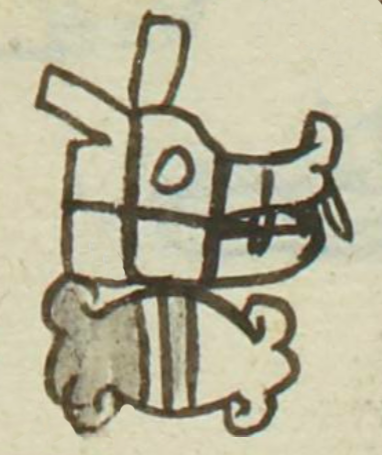Texolohua (MH553r)
This black-line drawing of the compound glyph for the personal name Texolohua (“One Who Has a Stone Carving of Xolotl [or, a Xoloitzcuintli Dog],” attested here as a man’s name) shows a horizontal stone with its classic curling ends and alternating stripes. Above the stone is a profile view of the head of a dog called the xoloitzcuintli with protruding teeth, a turned up nose, and a seemingly open eye. The head of the dog also has vertical and horizontal intersecting lines at right angles, which remove it from the realm of just a pet and into the realm of a sacred force.
Stephanie Wood
The name Texolohua was held by a Mexica noble, so perhaps it is borne here in memory of that famous person. [See: Jesús Monjarás-Ruiz, La nobleza mexica (1980), 84.] In trying to understand what the name means, one wonders whether a stone carving of Xolotl, the divine force of lightning and death, is intended or just a dog, the xoloitzcuintli. A stone effigy of a divine force makes more sense than a stone dog. The itzcuintli glyphs from this same manuscript do tend to have turned-up noses. The Xolotl glyphs from the Codex Mendoza sometimes have one vertical line of paint on the face. These lines resemble the face paint or tattooing of the Otomí glyph, although those lines are red.
Images of Ehecatl and Xolotl can have face paint, perhaps some indication of their divinity. Alternatively, the face paint or tattooing could represent the "hua" possessor syllable here, recalling the term xahua (to paint oneself), which has been suggested by Julio Alfonso Pérez Luna in Lenguas en el México novohispano y decimonónico (2011), citing Alfonso Lacadena's analysis of various "hua" syllables.
Stephanie Wood
texolovā
Texolohua
Stephanie Wood
1560
José Aguayo-Barragán and Stephanie Wood
tatuaje, pintura en la cara, perros, itzcuintles, piedras

te(tl), stone, https://nahuatl.wired-humanities.org/content/tetl
Xolotl, divine force of lightning and death, https://nahuatl.wired-humanities.org/content/xolotl
xoloitzcuin(tli), a native Mexican nearly hairless dog, https://nahuatl.wired-humanities.org/content/xoloitzcuintli
-hua, singular possession, https://nahuatl.wired-humanities.org/content/hua
Él que Tiene un Xoloitzcuintli en Piedra
Stephanie Wood
Matrícula de Huexotzinco, folio 533r, World Digital Library. https://www.loc.gov/resource/gdcwdl.wdl_15282/?sp=185&st=image
This manuscript is hosted by the Library of Congress and the World Digital Library; used here with the Creative Commons, “Attribution-NonCommercial-ShareAlike 3.0 License” (CC-BY-NC-SAq 3.0).










